Different Types of Trees
Key Difference: Tree is a woody perennial plant which is characterized by its elongated stem which assists various branches. Trees are often armed with leaves. Trees can be classified on various bases like – biological class, duration of holding leaves, branching, etc.
Tree is a woody perennial plant as it grows for more than two years. Their parts which are above the grounds remain preserved during the winter and then again resume growing during the spring. Trees can be divided by considering many contexts.
Primarily, trees can be divided into two main groups known as Gymnosperms and Angiosperms on the basis of biological class.
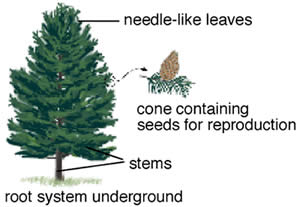 Gymnosperms – It refers to those trees which bear no flowers and possess seeds which get exposed in the open air and are available for pollination by wind. The term gymnosperm means naked seeds referring to the fact that the seeds are not enclosed within fruits but exposed directly to the air. Their seeds usually have structures similar to cones. Conifers which have needle leaves fall into the group of gymnosperms. Pines, firs and cedars are examples of trees from this group.
Gymnosperms – It refers to those trees which bear no flowers and possess seeds which get exposed in the open air and are available for pollination by wind. The term gymnosperm means naked seeds referring to the fact that the seeds are not enclosed within fruits but exposed directly to the air. Their seeds usually have structures similar to cones. Conifers which have needle leaves fall into the group of gymnosperms. Pines, firs and cedars are examples of trees from this group.
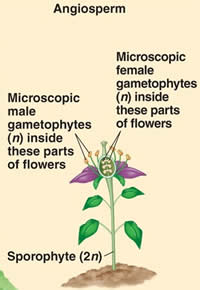 Angiosperms – These are opposite to gymnosperms as they produce flowers. Trees belonging to this category are often termed as hardwoods. These trees usually have broad leaves which change their color and die at every autumn season. Sweetbay Mangola and live Oak are examples of angiosperms. Their seeds are encased inside fruits.
Angiosperms – These are opposite to gymnosperms as they produce flowers. Trees belonging to this category are often termed as hardwoods. These trees usually have broad leaves which change their color and die at every autumn season. Sweetbay Mangola and live Oak are examples of angiosperms. Their seeds are encased inside fruits.
Trees can also be divided on the basis of duration of the leaves –
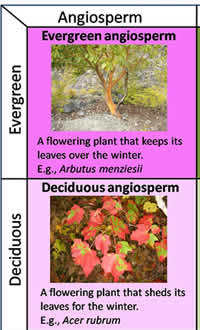 Evergreen trees – These trees retain their leaves throughout the year. This type of tree is never deprived of leaves, as leaves grow and renew at the time when some leaves fall and die. Trees in this category can be further categorized into two groups –
Evergreen trees – These trees retain their leaves throughout the year. This type of tree is never deprived of leaves, as leaves grow and renew at the time when some leaves fall and die. Trees in this category can be further categorized into two groups –
Trees with leaves as scales or needles – These evergreen trees have needle shaped or scaled narrow leaves. These leaves are usually firm and have resin the exterior surface. It includes coniferous tress like pines and cedars.
Trees with evergreen broad leaves – These evergreen trees have broader leaves and most of them are found in the equatorial areas of tropics. They have a wide canopy due to which plants falling in its lower strata are not able to get enough sunlight. Magnolia is an example of this type of tree.
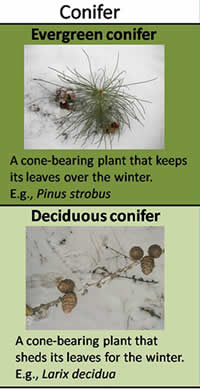 Deciduous Trees – These trees do not retain leaves throughout the year. They are usually round in shape as compared to coniferous trees. Maples and oaks are examples of deciduous trees. These trees usually require a warm climate and water. These trees also take longer time to grow.
Deciduous Trees – These trees do not retain leaves throughout the year. They are usually round in shape as compared to coniferous trees. Maples and oaks are examples of deciduous trees. These trees usually require a warm climate and water. These trees also take longer time to grow.
The leaves of these trees are larger and wider and therefore provide more area for photosynthesis. Due to its larger size, the leaf of this tree is not very strong, especially to bear the harsh conditions like in winters. That is why most of these trees shed their leaves during autumn. These trees are known for their good preservation quality. Wood of these trees is usually expensive than in comparison to other trees.
Trees can be further divided on the basis of their branching –
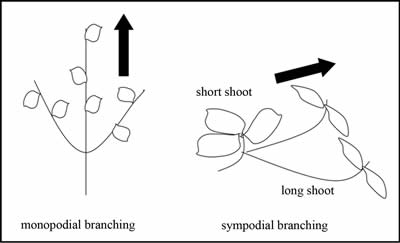 Monopodial Trees – Growth in these trees is characterized by terminal bud producing new leaves and stems, and still maintaining a growing point at the tip. Side branches get developed from the main stem and these branches are shorter and thinner. These branches usually develop in right angles and that is why they look triangular in shape. This shape helps them to curb excess of snow.
Monopodial Trees – Growth in these trees is characterized by terminal bud producing new leaves and stems, and still maintaining a growing point at the tip. Side branches get developed from the main stem and these branches are shorter and thinner. These branches usually develop in right angles and that is why they look triangular in shape. This shape helps them to curb excess of snow.
Sympodial Trees – In these trees, the terminal bud of the main shoot stops to grow or either terminates into a flower. Lateral buds then continue the process of growth, as new side branches develop from lateral bud or buds. Branches developed from the lateral buds work as the main primary axis.
Image Courtesy: lrrpublic.cli.det.nsw.edu.au, majordifferences.com, kaleidoscopeflux.blogspot.com, file.scirp.org









Add new comment